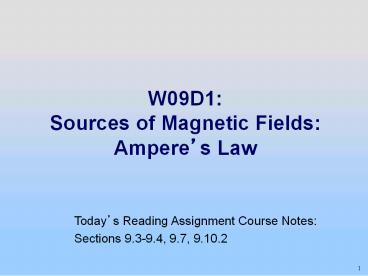W09D1: Sources of Magnetic Fields: Ampere - PowerPoint PPT Presentation
Title:
W09D1: Sources of Magnetic Fields: Ampere
Description:
W09D1: Sources of Magnetic Fields: Ampere s Law Today s Reading Assignment Course Notes: Sections 9.3-9.4, 9.7, 9.10.2 * Class 20 * Class 20 * Class 20 * Class 20 ... – PowerPoint PPT presentation
Number of Views:63
Avg rating:3.0/5.0
Title: W09D1: Sources of Magnetic Fields: Ampere
1
W09D1Sources of Magnetic Fields Amperes Law
Todays Reading Assignment Course Notes
Sections 9.3-9.4, 9.7, 9.10.2
2
Announcements
Math Review Week Nine Tuesday from 9-11 pm in
26-152 PS 7 due Tuesday April 9 at 9 pm in
boxes outside 32-082 or 26-152 Next reading
Assignment W09D2 Faradays Law Course Notes
Sections 10.1-10.4
3
Today Biot-Savart vs. Ampere
4
Last TimeCreating Magnetic FieldsBiot-Savart
5
The Biot-Savart Law
Current element of length carrying current
I produces a magnetic field at the point P
6
The Biot-Savart Law Infinite Wire
Magnetic Field of an Infinite Wire Carrying
Current I from Biot-Savart See W06D3 Problem
Solving http//web.mit.edu/8.02t/www/materials/Pr
oblemSolving/solution05.pdf
More generally
7
3rd Maxwell Equation Amperes Law(we will
eventually add one more term to this equation)
Open surface is bounded by closed path
8
Amperes Law The Idea
In order to have a B field around a loop, there
must be current punching through the loop
9
Concept Question Line Integral
The integral expression
- is equal to the magnetic work done around a
closed path. - is an infinite sum of the product of the tangent
component of the magnetic field along a small
element of the closed path with a small element
of the path up to a choice of plus or minus sign.
- is always zero.
- is equal to the magnetic potential energy between
two points. - None of the above.
10
C.Q. Answer Line Integral
2. A line integral by definition is the sum
- We need to make a choice of integration
direction (circulation) for the line integral.
The small line element is tangent to the
line and points in the direction of circulation.
The dot product therefore is the product of the
tangent component of the magnetic field in the
direction of the line element. So the answer
depends on which way we circulate around the
path.
11
Current Enclosed
Current density
Current enclosed is the flux of the current
density through an open surface S bounded by the
closed path. Because the unit normal to an open
surface is not uniquely defined this expression
is unique up to a plus or minus sign.
12
Sign Conventions Right Hand Rule
Integration direction clockwise for line integral
requires that unit normal points into page for
open surface integral Current positive into page,
negative out of page
13
Sign Conventions Right Hand Rule
Integration direction counterclockwise for line
integral requires that unit normal points out of
page for open surface integral Current positive
out of page, negative into page
14
Concept QuestionsAmperes Law
15
Concept Question Amperes Law
Integrating B around the loop shown gives us
- a positive number
- a negative number
- zero
16
C.Q. Answer Amperes Law
- Answer 3. Total enclosed current is zero, so
17
Concept Question Amperes Law
Integrating B around the loop in the clockwise
direction shown gives us
- a positive number
- a negative number
- zero
18
C.Q. Answer Amperes Law
- Answer 2.
- Net enclosed current is out of the page, so field
is counter-clockwise (opposite to circulation
direction)
19
Applying Amperes Law
- Identify regions in which to calculate B field.
- Choose Amperian closed path such that by symmetry
B is zero or constant magnitude on the closed
path! - Calculate
- Calculate current enclosed
- Apply Amperes Law to solve for B check signs
20
Infinite Wire
A cylindrical conductor has radius R and a
uniform current density with total current I. we
shall find the direction and magnitude of the
magnetic field for the two regions (1) outside
wire (r R) (2) inside wire (r lt R)
21
Worked Example Amperes Law Infinite Wire
I
B
I
Amperian Closed Path B is Constant
Parallel Current penetrates surface
22
Example Infinite Wire
Region 1 Outside wire (r R)
Cylindrical symmetry ? Amperian Circle B-field
counterclockwise
23
Group Problem Magnetic Field Inside Wire
We just found B(rgtR) Now you find B(rltR)
24
Infinite Wire Plot of B vs. r
25
Group Problem Non-Uniform Cylindrical Wire
A cylindrical conductor has radius R and a
non-uniform current density with total
current Find B everywhere
26
Other Geometries
27
Two Loops
http//web.mit.edu/viz/EM/visualizations/magnetost
atics/MagneticFieldConfigurations/tworings/tworing
s.htm
28
Two Loops Moved Closer Together
29
Multiple Wire Loops
30
Multiple Wire Loops Solenoid
http//youtu.be/GI2Prj4CGZI
31
DemonstrationLong Solenoid
http//tsgphysics.mit.edu/front/?pagedemo.phplet
numG2018show0
32
Magnetic Field of Solenoid
Horiz. comp. cancel
loosely wound
tightly wound
For ideal solenoid, B is uniform inside zero
outside
33
Magnetic Field of Ideal Solenoid
Using Amperes law Think!
34
Group Problem Current Sheet
A sheet of current (infinite in the y z
directions, of thickness d in the x direction)
carries a uniform current density Find the
direction and magnitude of B as a function of x.
35
Amperes LawInfinite Current Sheet
B
I
B
Amperian Loops B is Constant Parallel OR
Perpendicular OR Zero I Penetrates
36
Surface Current Density
A very thin sheet of current of width w carrying
a current I in the positive z-direction has a
surface current density For sheet of thickness d
, width w, and current I
37
Solenoid is Two Current Sheets
Consider two sheets each of thickness d with
current density J. Then surface current per unit
length Use either Amperes Law or
superposition principle
38
Biot-Savart vs. Ampere
39
Amperes Law
Long Circular Symmetry
(Infinite) Current Sheet
2 Current Sheets
Solenoid
Torus































